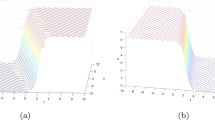Abstract
We have systematically explored the application of generalized operator representation including P-, W-, and Husimi representation in the time evolution of quantum systems. In particular, by using the method of differentiation within an ordered product of operators, we give the normally and antinormally ordered forms of the integral kernels of Husimi operator representations and its corresponding formulations. By making use of the generalized operator representation, we transform exponentially complex operator equations into tractable phase–space equations. As a simple application, the time evolution equation of Husimi function in the amplitude dissipative channel is clearly obtained.
Similar content being viewed by others
References
Glauber, R.J.: Coherent and incoherent states of the radiation field. Phys. Rev. 131(6), 2766–2788 (1963)
Sudarshan, E.C.G.: Equivalence of semiclassical and quantum mechanical descriptions of statistical light beams. Phys. Rev. Lett. 10(7), 277–279 (1963)
Walls, D.F., Milburn, G.J.: Quantum Optics. Springer, Berlin (1994)
Wigner, E.: On the quantum correction for thermodynamic equilibrium. Phys. Rev. 40(5), 749–759 (1932)
Husimi, K.: Some formal properties of the density matrix. Phys. Math. Soc. Jpn. (Nippon Sugaku-Buturigakkwai Kizi Dai 3 Ki) 22(4), 264–314 (1940)
Carmichael, H.J.: Statistical Methods in Quantum Optics I: Master Equations and Fokker-Planck Equations. Springer, Berlin (2002)
Gardiner, C.W.: Quantum Noise. Springer, Berlin (1991)
Wünsche, A.: About integration within ordered products in quantum optics. J. Opt. B: Quantum Semiclass. Opt. 1(3), R11–R21 (1999)
Scully, M.O., Zubairy, M.S.: Quantum Optics. Cambridge University Press, London (1997)
Hong-Yi, F., Zaidi, H.R., Klauder, J.R.: New approach for calculating the normally ordered form of squeeze operators. Phys. Rev. D 35(6), 1831–1834 (1987)
Hong-Yi, F., Zaidi, H.R.: Squeezing and frequency jump of a harmonic oscillator. Phys. Rev. A 37(8), 2985–2988 (1988)
Hong-Yi, F., VanderLinde, J.: Simple approach to the wave functions of one-and two-mode squeezed states. Phys. Rev. A 39(3), 1552–1555 (1989)
Fan, H.Y., Yang, Y.L.: Weyl ordering, normally ordering of Husimi operator as the squeezed coherent state projector and its applications. Phys. Lett. A 353(6), 439–445 (2006)
Fan, H.Y., Zaidi, H.R.: Application of IWOP technique to the generalized Weyl correspondence. Phys. Lett. A 124(6), 303–307 (1987)
Walls, D.F.: Squeezed states of light. Nature 306(5939), 141–146 (1983)
Drummond, P.D., Gardiner, C.W.: Generalised P-representations in quantum optics. J. Phys. A: Math. Gen. 13(7), 2353–2368 (1980)
Acknowledgments
This work was supported by the Natural Science Foundation of the Colleges and Universities in Anhui Province under Grant: Nos. KJ2013A258 and KJ2013A261, Anhui Provincial Natural Science Foundation under Grant: No. 1408085MA20, and the Fund of the Education Department of Anhui Province of China under Grant: No. gxyqZD2016242.
Author information
Authors and Affiliations
Corresponding author
Appendix
Appendix
\(\Delta (\alpha ,\alpha ^{*})\)’s antinormally ordered form
We can obtain through the procedure as follows:
Proof
Due to
we have
Using
we can obtain
Because
and using the formulation
here, \(H_{m,n}(x,y)\) is Hermite polynomial, we can derive
Using
and using
where \(L_{n}\) is Laguerre polynomial, we can obtain
From this, we have
\(\square \)
Rights and permissions
About this article
Cite this article
He, R., Liu, X. & Song, J. Application of generalized operator representation in the time evolution of quantum systems. Quantum Inf Process 15, 4325–4336 (2016). https://doi.org/10.1007/s11128-016-1386-9
Received:
Accepted:
Published:
Issue Date:
DOI: https://doi.org/10.1007/s11128-016-1386-9




